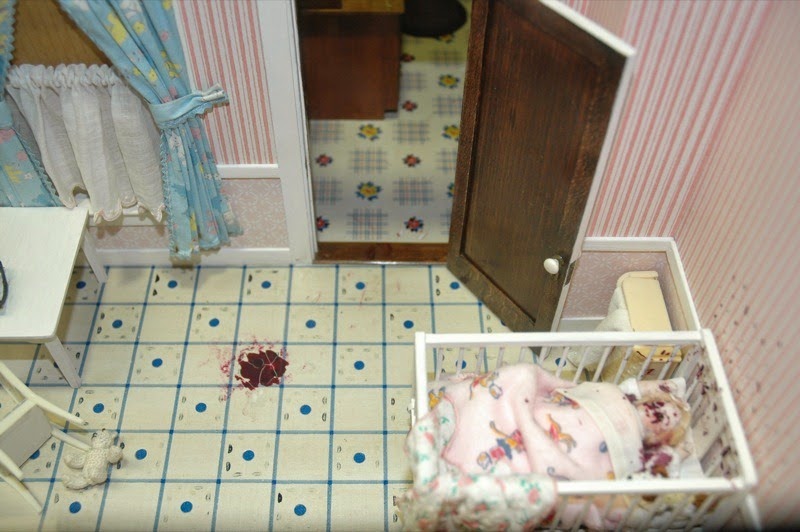On the third floor of the Office of the Chief Medical Examiner for the state of Maryland, in Baltimore, the United States, the chief medical officer and his deputies deliver lectures to trainee police officers on the art and science of crime scene investigation. The medium of choice for such seminars is, of course, PowerPoint presentations, but the instructors have other tools in their arsenal. One one side is a series of 18 glass cases, each containing a dollhouse-like diorama depicting gruesome crime scenes. In one, a lady appears to have been shot dead on the bed while sleeping. A man lies sprawling on the floor next to her, his night clothes stained with blood. The room is in a disarray. Inside another glass case, a body has been violently shoved down into a bath tub with the water running. There is blood on the floor and tiny hand prints on the bathroom tiles.
A miniature crime scene diorama from “The Nutshell Studies of Unexplained Death”. Photo credit
These models are known as the “Nutshell Studies of Unexplained Death” and were built by Frances Glessner Lee, a wealthy socialite and heiress, who dedicated her life to the advancement of forensic medicine and scientific crime detection. Nicknamed “the mother of forensic investigation”, Lee’s murder miniatures and pioneering work in criminal sciences forever changed the course of death investigations.
Lee created these miniature crime scenes, on a scale of one inch to one foot, from actual police cases from the 1930s and 1940s, assembled through police reports and court records to depict the crime as it happened and the scene as it was discovered. They were built to be used as police training tools to help crime scene investigators learn how to assess evidence and apply deductive reasoning. More than 70 years later, they are still used by forensic investigators.
Frances Glessner Lee was born in Chicago. Her father, John Jacob Glessner, was an industrialist who became wealthy from International Harvester. Although she and her brother were educated at home, Lee was not permitted to attend college and instead married off to a lawyer. Her brother, however, went to Harvard. The seeds of her interest began through her association with her brother's college classmate, George Burgess Magrath, who was then a medical student. But it wasn’t until the age of 52, after a failed marriage and three children, she finally got the opportunity explore her interest.

Lee understood that through careful observation and evaluation of a crime scene, evidence can reveal what transpired within that space. But the local coroners responsible for determining cause of death were not required to have medical training and many deaths were wrongly attributed. Together with Magrath, who later became a chief medical examiner in Boston, they lobbied to have coroners replaced by medical professionals.
In 1931 Lee helped to establish the Department of Legal Medicine at Harvard, the only such program then in existence in North America. In 1943, Lee was appointed honorary captain in the New Hampshire State Police, the first woman in the United States to hold such a position. Around the same time, she began work on the Nutshell Studies of Unexplained Death.
Convinced by criminological theory that crimes could be solved by scientific analysis of visual and material evidence, she constructed a series of dioramas that she called “The Nutshell Studies of Unexplained Death”, to help investigators “find the truth in a nutshell”. The point was not to solve the crime in the model, but to observe and notice important details and potential evidence - facts that could affect the investigation.
For example, in one glass box, a woman found dead in her small, messy bedroom by her landlord appears to be peacefully sleeping. But pulling a string on the box lifts the pillow to reveal a red lipstick stain, evidence that she could have been smothered.
Lee created her crime scenes from actual police cases but the design of each dollhouse was her own invention. Many display middle-class décor with garish decorations and tawdry furnishings. Her first model was “The Case of the Hanging Farmer" that she built in 1943 and took three months to assemble. Her full-time carpenter Ralph Moser assisted her in all of the constructions, building the cases, houses, apartments, doors, dressers, windows, floors and any wood work that was needed. Lee built the dolls and painted them.
The detail in each model is astounding. The lights work, cabinets open to reveal actual linens, whisks whisk, and rolling pins roll. She knitted or sewed all the clothing each doll wears, and hand painted, in painstaking detail, each label, sign, or calendar.
Lee and Ralph Moser together built 20 models but only 18 survived. She originally presented the models to the Harvard Department of Legal Medicine in 1945 for use in teaching seminars and when that department was dissolved in 1966, they were transferred to the Maryland Medical Examiner’s Office, in Baltimore, where they remain. The models are not accessible to the public, but anyone with professional interest may arrange a private viewing.

Sources: Telegraph / National Institutes of Health / Death in Diorama / Baltimore Sun































Grammar check: "A man lay sprawling" should be "A man lies sprawling."
ReplyDeleteWhy don't you check your own writing? Here's an example from one of your posts: Not Before You're Ready
Delete"My husband, Steve, and me at our son's recent graduation from his trade program." Shouldn't that be My husband, Steve, and I?
No, me is correct in this sentence. One way to tell is to try the sentence without Steve (in this example). You would say, "me at our son's recent graduation". You would not say, "I at our son's recent graduation".
Delete